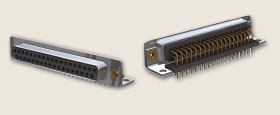

Do you remember how big and blocky cellphones were back in the ’80s? Think of the film Wall Street‘s Gordon Gekko. He was practically holding a brick to his ear, not to mention the briefcase to go with it. But over the past 20-odd years, cellphones have shrunk down so much that they can easily be slipped into pockets or toted around in tiny clutch purses.
As the downsizing of cellphones illustrates, the quest to create electronics in smaller and smaller packages continues as demand for pint-sized equipment grows. The holy grail seems to be a computer the size of a pinhead and entertainment electronics that can be slipped into a wallet. However, because of the limitations of materials and the constraints of manufacturing, these goals will be difficult to achieve.
The electronic power supply industry and its related power interconnects are no exception to these demands and inherent limitations. Connectors today must be small but mighty. Keeping all that in mind, this article discusses why solid contact connectors are the best way to achieve high power density.
Achieving high power density
Like most electronics, connectors have been steadily shrinking as the years have passed. However, their small size must be capable of superior power density so that they can keep up with powerful microprocessors and other components that demand increased current. This is a problem because as current flow increases, more heat is generated. Normally, space is added to reduce heat, but that goes against the goal of miniaturisation.
To complicate the situation, agencies like UL and TUV regulate connector parameters (creepage and clearance distances, for example) to help ensure safety, but alas, this further impedes the pursuit of downsizing.
For the past 40 years, the interconnect world has been highly influenced by ‘stamped’ contact technology connectors. This technology has helped make mass-produced electronic goods more affordable. To solve the problem of high current distribution, stamped contact connector manufacturers have offered the blade connector, which uses power contacts with large flat sections of folded sheet metal. Although the blade connector has an attractive cost, it is not particularly dense or small in size.
So, to achieve maximum power density, an older connector technology has been rediscovered: the solid-machined or precision-machined contact connector. Solid contact connectors, when used in combination with advanced mating area designs, offer up to two times more power density than a blade connector. That means that a solid contact power connector can transfer two times more amperage than a blade connector occupying the same space. And that’s just one of the many benefits of solid contact connectors.
Exploring the benefits
Solid contact connectors have a long history. They have been in use for 70 years or more. They utilise contacts ‘turned’ or machined on precision lathes, equipment initially invented for the Swiss watch industry. When stamped contact connectors became more popular in the 1970s, solid contact connectors were often relegated to higher reliability applications (like those in the medical or aerospace industries), but because of their unique capabilities, they weren’t forgotten. And as already discussed, more recently they’ve seen increased use to help maximise power density.
They offer solid mass for the transfer of current. When compared with stamped contact products, solid contact connectors have more solid metal in the spatial contact area. For the transfer of current, this solid mass increases efficiency.
They maintain low contact resistance. Interconnect designers must also provide a male-to-female mating system that ensures a large surface area of ‘embrace’, or surface-to-surface connection. This is key to maintaining low contact resistance levels and enabling maximum current-carrying capacity. Solid contact designs can offer contact resistances that are a fraction of those found in common stamped contact connectors. This is why solid contact connectors can transfer two times more power than blade connectors.
With solid contacts, designers can use smaller connectors and less materials. In cable connector applications, additional advantages are seen. Solid contacts again enable the power system designer to use a smaller connector, as fewer contacts are needed to meet the power requirement. Continuing this train of thought, less wiring is required, less material is needed, and less assembly time is required.
They are strong and durable. Solid contacts are just that: solid metal. They are typically made of brass and bronze alloys, making them durable and less prone to bending and damage. Possible contact harm due to misalignment is a reality when blind mating is involved, so using a more durable contact, as is offered through solid contact technology (as opposed to stamped technology), is a smart way to further ensure system reliability and protect against field failures.
Summary
There are many benefits to solid contact connectors, and these advantages are accentuated in the power supply world. The solid mass they offer increases power density and defends against potential damage of mating misalignment. But the solid mass is not enough. So, connector designers engineer solid contacts that have an enlarged area of ‘embrace’ to increase the surface area of the male-to-female connection. A truly superior power interconnection is the result, with power connectors that have up to two times more power density than common blade connectors.
Although the cost is sometimes higher for this age-old, but now seemingly advanced interconnection technology, life cycle cost can be lower, especially if smaller packaging is really an issue and reliability is important. So, if size reduction is key to a system design and power connectors are part of that issue, solid contact connectors clearly offer the highest density solution, if not the best all-around technical choice.
For more information contact Hiconnex, +27 (0)12 661 6779, [email protected], www.hiconnex.co.za
| Tel: | +27 12 661 6779 |
| Email: | [email protected] |
| www: | www.hiconnex.co.za |
| Articles: | More information and articles about Hiconnex |

© Technews Publishing (Pty) Ltd | All Rights Reserved